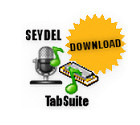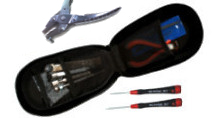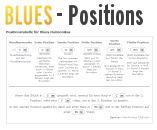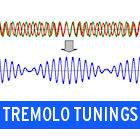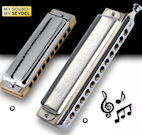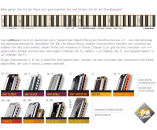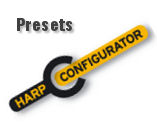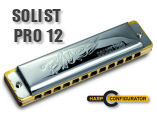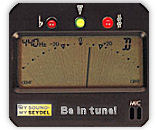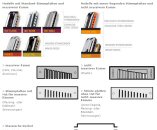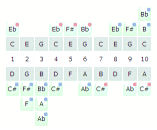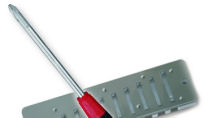Info worth knowing
|
FAQ - frequently asked questions - please click a ▸topic: In general there are four different types of harmonicas, namely Blues,
Chromatic, Tremolo and Oktave-models. Each of these are suited for different
musical styles. Especially beginners should be especially aware of the fact that their
first instrument should be a good one. Buying cheap like with other products
can lead to frustration or, even worse to giving up learning a new musical
instrument. All SEYDEL Harmonicas are high-grade instruments - made in Germany - those
with stainless steel reeds have the best price-performance ratio. Seen from a technical point of view harmonica reeds are springs and stainless
steel is a better spring material than brass. The upper load limit and
the spring momentum is higher than with brass and this has thoroughly positve
effects on the dynamic range of the sound, the tuning stability
and the durability of our models with stainless steel reeds. The reed response of stainless steel reeds is nearly identical to those of
brass reeds, however the sound has a higher proportion of overtones.
>Here
you will find a sound comparison measurement between brass and stainless steel
reeds All of the harmonica combs from the Blues series have the same hole spacing
and all of them are suited for beginners. On the low and high models from
the 1847 series the thickness of the comb is a little bit different (1mm)
compared to the standard keys. So there is no Blues model that is especially
suited for playing individual notes easier than on another model! Playing individual notes should not be fatiguing. The lipps should
be pursed effortlessly. The shape/embouchure is similar to whistling a low
note: the lower jaw is a little bit opened and the resulting "lip setting"
can be watched in a mirror: the "aperture" is suited wel for playing
a single note. This technique is called "pucker embouchure". The harmonica is then placed on the lower lip and the note "is breathed"
(the mouth cavity forms an "ouh" or an "uh" shape, do
not puff the air, just breath!). If you still hear two notes the instrument
can be relocated to the left or the right rather than contracting the lip
muscles even more. They should stay relaxed and so do not rehearse too
long. Instead of playing for half an hour at one push, you'd better play five
times for five minutes with a one minute pause in between. After a while you will not think about you embouchure any more! You can rely
on this fact, so give yourself the patience needed to master this technique.
How we tune exactly can be found >here. Bending notes: the bending pitch range of a note (draw or blow) depends
on the interval the reeds within one hole are tuned in. E.g. if they are tuned
to a third with 4 semi-tones, like in 3 draw on a Richter harmonica, you can
bend down and reach the semi-otes in between this interval - take hole 3 on a C-harmonica:
If the draw note is a B and the blow note is a G, you will be able to play
the Bb the A, the Ab as bending notes. In hole 2 however the pitch of the
draw and blow note is only 3 semi-tones apart: blow 2 = E and draw 2 = G.
Therefore you have only two draw bending notes in hole 2, namely the F# and
the F. In 1 blow you find a C in 1 draw there is a D. The resulting bending
note is a Db/C#. In the lower registers (1-6) all draw notes are higher in tune than the corresponding
blow notes (in one hole!). That is why you get draw bendings. In holes 7-10 it is vice versa,
so you will get blow bends only, following the same principle of the "dual
reed bending". Valving: If you cover a draw reed with a valve, eg in 1 to 4, you
can still get the usual draw bendings like described above. However if you
blow a note the valve closes the draw reed and you can get out a so called
"single reed bending" (the valve prevents the interaction of the
two reeds). The pitch range is a semi-tone maximum. Low harmonicas with valves: On nearly all of our low harmonicas that have
valves on the lower draw reeds, it is theoretically possible to get both,
the usual draw dual-note bending notes and the addional single-note blow bendings
in each hole. In practice one problem remains: You have to build a really
large mouth cavity for producing the bent notes. Very low bending notes physically
need a long air-coumn to alter their frequency. This is physically rescricted
to the player's ability to form a huge mouth cavity. If you are starting with bending you better use a Bb a C or a D harmonica
to get the best results - after a while you will also learn lower tuned harmonicas
- step-by-step! >Here
you will find even more info about half and full valving For sure it is possible to play in all 12 keys on a C/C# chromatic harmonica.
All the 12 notes of the chromatic scale are available through three (or four)
octaves (these correspondent to all the white and black keys on a piano). If you take a deeper look to the tonal layout of a chromatic harmonica (this
is called ‚Solo tuning', pls. refer to the tone tables on the product
pages), you will see that you will get the C-Major chord if you blow (C, E,
G, C) and the D-Minor6 chord (D F A B) if you draw three or four notes at
once. If you like to play the Major Scale as single notes you will not need those
notes that become available by pressing the slider. The C-Major scale consists
of the notes: C, D, E, F , G, A, B, C. If you like to play a Major scale
(or melodies) in another key you will need additional notes than those of
the C-Major scale. As well the breathing patterns and slider usage will change
depending on the root-note of the new key you like to play in. It is more or less easy to play melodies in C or in Am, or F or Dm on a C/C#-chromatic. Playing in G Major and Em is okay, too. Being able to play fluently in other
keys than these, requires even more rehearsing...or you use
chromatic instruments that are tuned directly in the required keys. If you
do so you can play just like you'd play in C on a standard C/C# Chromatic: your breathing
patterns and the slider usage will stay the same. So it depends on what your goal is: rehearsing a lot in order to get familiar
to play in all 12 keys on a standard C/C#-Chromatic (e.g. if you'd like to play
free Jazz improvisation). Or you choose the „easy way“ instead and
get you chromatic instruments in keys different from C/C# to be able to play
in different keys more easily. However if you intend not to play by ear but play fixed pieces with the aid of harmonica tabs
or by using sheet music you will be able to play everything on a standard C/C#
in any key. The chromatic harmonica was only invented when the diatonic was already existing for a long time.
Thus, many players were used to playing on C harmonicas in Richter tuning (Joseph
Richter in Haida/Bohemia in 1825). The so-called "central octave" of the Richter
diatonic (holes four through seven) was the basis for playing major-based melodies,
which were usually accompanied with "vamping" on the chords (e.g. tonic C and
dominant G) in holes 1-3 using the reed block technique. As the term "diatonic" implies, these harmonicas could not be played fully
chromatically or in other keys than the one indicated on the instrument (this
was/is common in instruments for playing folk melodies, think for example of
concertinas or other small accordion-like instruments). The fact is that solo
tuned chromatic, like diatonic, always "sounds" good, whether you are an absolute
beginner or an advanced player. The beautiful sounding chords that are readily
available also remain a good selling point. The players' goal, however, was to have a harmonica that made all 12 notes
of the chromatic scale available, and what they did was to take the tonal layout
of the already very familiar "central octave", multiply it, and simply insert
a slide and another reedplate tuned a semitone higher to automatically have
all the notes of the chromatic scale available. The chromatic harmonica with
a slide as we know it today was "born" around 1910, although there were many
prototypes going in a similar direction long before that (SEYDEL patent of 1884
on moveable and muteable reeds in harmonicas and accordions). If you leave out the slide when playing, these (solo-tuned) instruments can
still be played like the well-known "diatonics" - a big advantage, because players
are always conservative and don't like to learn a completely new instrument.
Of course, there are more logical (symmetrical) tunings (diminished/augmented)
that eliminate the triple presence of the root note - but what they don't
have is the ability to play chords and lack the intuitive access when coming
from other diatonic harmonica (either blues, tremolo or octave). Thus, the tradition of solo tuning continues to this day and many players have
mastered playing complicated jazz in all keys on the C solo tuned chromatic.
There is not a single book on chromaticism that is based on any tuning other
than the Solo tuning. Moreover, there are music schools and serious conservatories
that teach classical music on the solo tuned chromatic. It is also a fact that
harmonica greats like Larry Adler did not play all the pieces in the keys in
which they were originally written. Some of the keys are just too difficult
to be played fluently. Today, many players use chromatics in keys other than C to be able to play in
"difficult" keys without having to learn new breathing/slider patterns. Perhaps there are
more "intelligent" tonal layouts that are more "logical" than the solo tuning
to play in all keys - but all of them then lack the connection to the Richter
tuning and you then are virtually learning a new instrument. |
SEYDEL Toolsets
Table of positions for Blues Harmonicas
Selected free Jamtracks on YouTube
Pitch range of harmonicas
Sound examples of our (Blues-) harmonicas ranging from double LowE (LLE) to High Bb (HBb)
Tonal range of our (Blues-) harmonicas ranging from double LowE (LLE) to High Bb (HBb)




